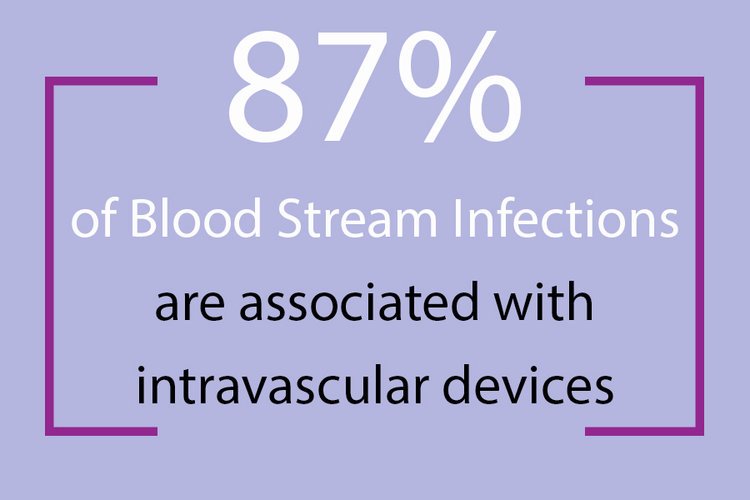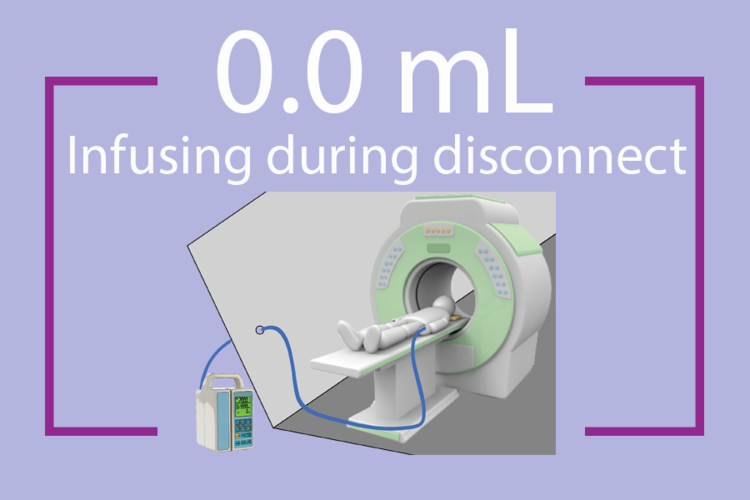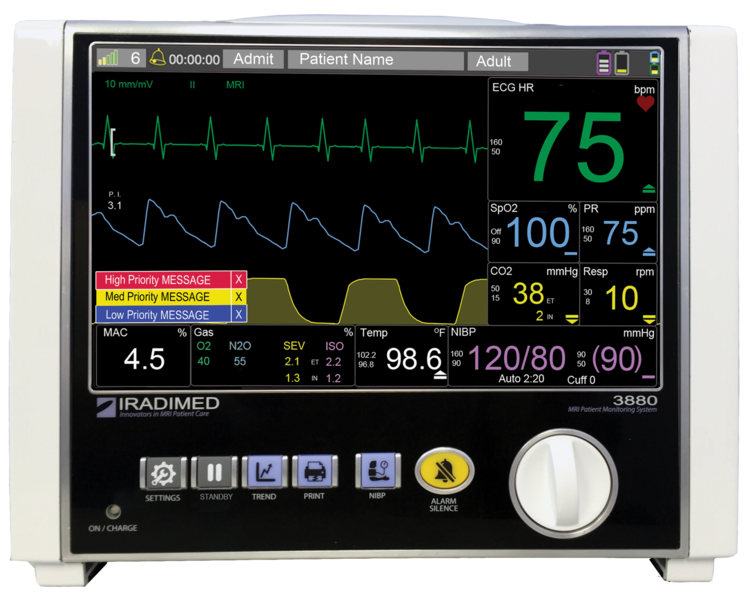
Infuse at the MRI Bore
MRI Safety is Patient Safety
In addition to the preventable magnetic attraction hazard, JCAHO warns that some “programmable infusion pumps may perform erratically”[1] when in the presence of a magnetic field. An evaluation of conventional infusion pumps within the MRI room found that the function was temporarily altered with three out of six infusion pumps during exposure to 3-Tesla MRI conditions.[3] IRadimed has been dedicated to advancing MRI safety with its Non-Magnetic[18] infusion pumps for nearly a decade. The MRidium system is the first and only infusion pump cleared to administer patient IV medications at the MRI bore*, directly contributing to JCAHO compliancy and safety when compared to using conventional magnetic infusion pumps.
IRadimed is the world’s only provider of Non-Magnetic IV infusion pumps. Infusing at the bore can improve the MRI care cycle while reducing operating costs. The MRidium Non-Magnetic IV infusion pump allows clinicians to infuse patient medications and fluids at the MRI bore, extending the same patient bedside practices to the MRI that are common throughout the rest of the hospital.
DO YOU USE TRADITIONAL IV PUMPS WITH EXTENSION LINES FOR MRI CASES?
ADDING LONG EXTENSIONS TO CONDUCT AN MRI SCAN CAN BE HARMFUL FOR PATIENTS.
Increased Risk of a HAI: Hospital Acquired Infection
HAIs (Hospital-Acquired Infections) are among the major causes of death and increased morbidity among hospitalized patients.[5] HAIs add to the functional disability and emotional stress of the patient and in some cases, lead to disabling conditions that reduce the quality of life.[5] Approximately 87% of bloodstream infections (BSI) are associated with the presence of some type of intravascular device.[6] Airborne contaminates often settle on floors where IV tubing may be inadvertently contaminated when allowed to contact the floor[7] or through subsequent manipulation of multiple connections and access ports. “Keep all IV tubing off the floor”[7] is one of the prevention measures that should be taken in the MRI. IRadimed’s MRidium infusion pumps operate at the bore* thereby reducing the chance IV tubing can contact the floor surfaces. Additionally, Non-Magnetic infusion pumps can minimize the number of IV connecting ports needed which can also decrease the potential for HAIs.
FURTHER EDUCATION EXAMPLES:
IV Extension Tubing Can Reduce the Flow Rate
300% More Flow Resistance can be experienced with 30 feet of IV lines versus a standard IV set.
The length of IV tubing directly impacts the resistance needed to push the medication through the tubing. Physics proves that tubing having twice the length will have twice the resistance, which reduces flow.[8,9] Each extension set addition, increases the fluid pathway requiring greater force and higher pressure (PSI) settings on the infusion pump. “It is dangerous if the pressure alarm limit is set too high”[10] as increasing the pressure limit (PSI) directly delays the time to activate the occlusion alarm[19]. “If a high alarm pressure has to be configured to sustain a high running pressure, there will be unavoidable consequences for patient safety, which should be understood.”[19] Clinical practice should create an environment where infusion pump “settings should be at the lowest appropriate pressure.”[10] IRadimed MRI infusion pumps allow you to infuse IV fluids at the bore* with the shortest possible IV line and lower pressure limit settings.
FURTHER EDUCATION EXAMPLES:
Occlusions Can Be Dangerous
> 0.5mL Possible Unintended bolus after occlusion release
IRadimed MRI infusion pumps deliver fluids at the bore* avoiding negative outcomes attributed to adding multiple IV extension sets. IV tubing “can easily be trapped in the closed [MRI] door”[4] increasing occlusion potential. The length of time it takes to detect an occlusion is directly related to the occlusion’s distance from the infusion pump. Increasing the IV tubing length has been demonstrated to prolong critical occlusion alarms by nearly 35 minutes[11] resulting in a delay of patient therapy.[10,19]
Once an occlusion happens, a patient will then inevitably suffer a significant period of time without the intended therapy.[19] Once the occlusion is released, an unintended bolus of medication occurs due to increased pressure generated in the IV tubing during the occlusion.[10,12,19] Post-occlusion boluses greater than 0.5 mL[13] have been demonstrated in a case study using standard bore extension IV tubing at ambient temperature. ECRI recommends that post-occlusion boluses should have a volume of 0.5 mL or less.[12] Depending on the situation, an unintended bolus greater than 0.5 mL could have a serious impact on a patient’s condition. A case study demonstrated that occlusions in the IV tubing greater than 8 feet (2.4 meters) away from the pump can exceed the 0.5 mL ECRI guideline.[13] IRadimed’s MRidium infusion pumps are designed to infuse at the bore* helping reduce the length of tubing needed for MRI infusions.
FURTHER EDUCATION EXAMPLES:
Don't Suffer From A (Re)Morse Code
Example of patient being tethered through a MRI wave guide
When a patient codes in the MRI, clinical staff find themselves in a situation where every second matters. When infusion extension lines are used to connect a pump from within the control room to the patient inside the MRI room, emergency evacuation becomes much more cumbersome and time consuming due to line management. Extension lines routed through a MRI waveguide present additional patient complexities since critical medication must be stopped in order to disconnect the lines and evacuate the patient while performing CPR. Infusing at the bore with the MRidium Non-Magnetic MRI infusion pump provides:
Faster Treatment: Infusing at the bore* utilizes shorter IV lines and allows emergency treatment to begin immediately.
Patient Safety: Critical infusions are maintained during the entire code event since IV tubing disconnection is not required to evacuate the patient.
Staff Efficiency: Clinicians have more time to focus on the patient instead of untangling IV tubing and manipulating access ports.
FURTHER EDUCATION EXAMPLES:
MRI Safety is Patient Safety
The value of a Non-Magnetic infusion pump may not be readily apparent until an adverse event occurs. This can be a life changing situation for the patient, staff and the facility. Joint Commission (JCAHO) mandates in ‘Sentinel Event 38’ that only equipment which “has been tested and approved for use during MRI scans”[1] should be used. Infusion pumps containing ferrous material may become projectile hazards when used within the MRI scanner room. For example “the infusion pump “flew” into the scanner and struck the patient, causing a 2-cm laceration to the patients chin.”[2,4]
In addition to the preventable magnetic attraction hazard, JCAHO warns that some “programmable infusion pumps may perform erratically”[1] when in the presence of a magnetic field. An evaluation of conventional infusion pumps within the MRI room found that the function was temporarily altered with three out of six infusion pumps during exposure to 3-Tesla MRI conditions.[3] IRadimed has been dedicated to advancing MRI safety with its Non-Magnetic[18] infusion pumps for nearly a decade. The MRidium system is the first and only infusion pump cleared to administer patient IV medications at the MRI bore*, directly contributing to JCAHO compliancy and safety when compared to using conventional magnetic infusion pumps.
FURTHER EDUCATION EXAMPLES:
Waste Not, Want Not
Example of potential cost savings using Propofol
IRadimed Non-Magnetic MRI infusion pumps allow clinicians to infuse at the bore* using fewer line connections and tubing. Shortening the length of IV tubing used may contribute to improved financial scenarios with the reduction of waste and HAI’s. Shorter IV lines reduce the amount of tubing and drug discarded after the MRI procedure. For example, 32.5 feet (9.9 meters / 390 inches) of common IV extension tubing will contain approximately 63.2 mL of medication per IV line. A comparison example utilizing Propofol at a cost of $40 per 100 mL illustrates a $28 savings** per patient IV medication. Infusing at the bore* means shorter lines, less waste and potential cost savings.
In addition to waste, HAIs can also negatively impact financial outcomes. According to CMS 2015 HAC List,[14] vascular HAIs are not eligible to receive additional payments to cover the incremental healthcare costs. The CDC estimates that Blood Stream Infections (BSI) can cost between $5,734 and $22,939[15] for a single incidence. A hospital-acquired IV infection increases a patient’s hospital stay by approximately 20 days[17] which greatly contributes to the incremental costs. Hospital-acquired infections add to the imbalance between resource allocation by diverting scarce resources to the management of potentially preventable conditions.
Critical Care Patients Need Their MRI Exams
In reviewing 25 years of U.S. malpractice claim payouts, Johns Hopkins researchers found that diagnostic errors accounted for the most severe patient harm, and the highest total of penalty payouts. They define diagnostic error as a diagnosis that is missed, wrong or delayed.[1]
Transporting critical patients for an MRI has demonstrated to have a good risk / benefit ratio. The results from diagnostic examinations have directly resulted in a change in patient therapy and management in up to 70% of critically ill patients[11].
Delaying a critically ill patient’s MRI diagnosis can be directly correlated to a delay in therapy which can result in a longer stay for the vast majority of cases.
FURTHER EDUCATION EXAMPLES:
DO YOU DELAY YOUR PATIENT'S MRI EXAM UNTIL THE IV THERAPY CAN BE DISCONTINUED?
MRI DELAY CAN BE MORE COSTLY AND HARMFUL THAN TREATMENT MISTAKES
Your Traditional IV Pump is Costing You
In reviewing 25 years of U.S. malpractice claim payouts, Johns Hopkins researchers found that diagnostic errors accounted for the most severe patient harm, and the highest total of penalty payouts. They define diagnostic error as a diagnosis that is missed, wrong or delayed.[1]
Waiting for a critically ill patient to be stable enough to discontinue all continuous IV infusions can delay their MRI diagnosis by several days. This MRI diagnosis delay can not only add significant cost but also delays a patient’s diagnosis, corresponding treatment, and release.
An average ICU cost per day is estimated at $3,184 US, climbing to $3,968 US when mechanical ventilation is needed. [2]
Malpractice Risks Increase Without a MRI Pump
In reviewing 25 years of U.S. malpractice claim payouts, Johns Hopkins researchers found that diagnostic errors accounted for the most severe patient harm, and the highest total of penalty payouts. They define diagnostic error as a diagnosis that is missed, wrong or delayed.[1]
“Overall, diagnostic errors have been underappreciated and under-recognized because they’re difficult to measure and keep track of“ Newman-Toker a Johns Hopkins researcher says. “These are frequent problems that have played second fiddle to medical and surgical errors” [1]
The practice of delaying an MRI diagnosis because the necessary equipment has not been acquired may end up costing you and your patients more in the long run.
IRadimed MRI Products
3880 MRI Patient Monitor
FMD Smart MRI Ferrous Metal Detector
Portable MRI IV Infusion Pump
3860+ MRI IV Infusion Pump System












